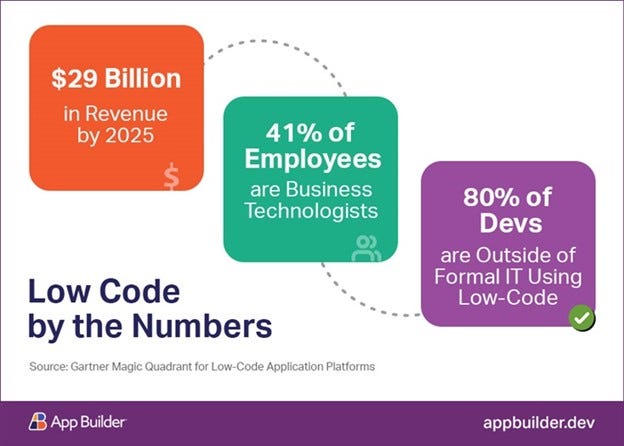Gen AI, Composable Apps, and Low Code Are Shaping Software
The combination of these three approaches to software can integrate application architectures such as super apps, micro apps, or composable apps.

At a Glance
- Generative AI
- Composable apps
- Low code
Three key trends are at the forefront of the digital revolution today – generative AI, composable apps, and low-code tools. But how likely are businesses and nay-sayers to start using artificial intelligence to break mundane patterns and improve productivity? What about low code and its power to transform processes, streamline app development, and even enable powerful data visualizations and reporting capabilities? Or composable apps, which may be an old concept but a new approach now? While many still attempt to avoid or resist these trends, the future of software development is starting to insist on their adoption more than ever.
Let’s look at why it is essential to leverage their capabilities and how exactly generative AI, composable apps, and low code are shaping the future of software development.
AI for Efficiency, Agility, and Enhanced Decision-Making
When adopting a new tool, establishing new programming paradigms, and looking at the final product, something always pops up as the most paramount – business value.
One of the most prominent and promising aspects of generative AI is that it significantly influences technology implementation by revolutionizing how tasks are automated, the ways in which content is generated, and what solutions are crafted. With the ability to understand and replicate patterns from vast datasets, generative AI finetunes models and adds innovation to the edges to improve solutions and processes for businesses and end-users.
According to Gartner, “By 2026, more than 80% of enterprises will have used generative artificial intelligence (GenAI) application programming interfaces (APIs) or models, and/or deployed GenAI-enabled applications in production environments, up from less than 5% in 2023.” This is because, firstly, generative AI not only revolutionizes how developers handle tasks and do their jobs, resulting in increased productivity. Secondly, these technologies move the software field forward so that it is easier now to build and retain business value. In other words, there is:
An increased developer productivity
An increased developer satisfaction
Undoubtedly, “generative AI has become a top priority for the C-suite and has sparked tremendous innovation in new tools beyond foundation models,” comments Arun Chandrasekaran, Distinguished VP Analyst at Gartner. “Demand is increasing for generative AI in many industries, such as healthcare, life sciences, legal, financial services and the public sector.”
In companies that harness the power of generative AI, developers can quickly go from “if-then” statements and questions to a final code. Let’s look at AI tools like ChatGTP or GitHub Copilot by Microsoft. These are technologies that evolve and help IT leaders see up to 3% improvements in productivity per month when using AI to generate code or build unit tests. GitHub data from one of the most recent surveys indicates that Copilot can deliver a productivity boost for everyone. Among developers who use GitHub Copilot, 88% of the developers who use GitHub Copilot say they are more productive, 74% say they can focus on more satisfying work, and 77% confirm the tool reduces the time spent searching for information or examples.
Moreover, with available data analysis plugins, people can take a whole data set from Excel or a JSON file, for example, and easily upload it to the AI tool. Then, they can do graphs, charts, or ask questions and the generative AI technology will handle all the data analysis. The purpose of it is to really boost productivity while the tool itself is adaptively learning about:
Patterns and structures from existing codebases
What a developer is trying to build
The purpose of a project and what needs to be automated
Different contexts that need to be improved for current tasks
This adaptability to evolving coding practices and instant tasks ensures that the AI remains relevant and effective over time. If an AI-driven system can promptly address queries or solve seemingly trivial issues, it can accomplish these tasks almost instantly. Although the generated code may not be 100% flawless, requiring someone to review it to ensure its usability and suitability for integration into the continuous development process, the efficiency gained allows for innovation and productivity levels beyond this stage.
However, one crucial aspect to keep in mind, though, is prompt engineering — mastering the art of formulating questions or prompts that provide the AI with additional context. This skill proves key in obtaining the answers that teams and businesses need from generative AI to deliver business value and outcomes.
Composability Is Becoming More Mature
Composable apps are not new. But this concept of composability now extends beyond what businesses and teams are traditionally thinking in terms of the user interface. In general, when we talk about this type of application, we refer to:
A particular type of modularity that delivers functionality as API or event-first business components
Data-sharing interfaces like single sign-ons, user preferences, or app usage history
A result that is known as Package Business Capability
Since technology and capabilities are more significant now, the idea of composable apps and how they bring more business value and better business outcomes is different than it was a couple of years ago. When we think about a composable app, something like a framework, it might not be all about the UI. So, once developers start building an app, they should think about API, event channel, and everything happening there to be able to consume someone else's data.
In other words, build composable apps, and you can define new sorts of business value in something much smaller, like a micro or a mini app that any framework on the market can use. But why is this important?
Let’s consider SuperApps (with WeChat and Alipay being just some of the examples that are gaining momentum now). Essentially, they are the front end of a platform that supports a composable business ecosystem, and they aggregate services, features, and functions into a single app. For instance, WeChat has 4.3 million mini apps as part of the framework. The way this type of composability and composable apps are shaping the future of software development is that unlike traditional apps that focus on specific functions, super apps aim to consolidate multiple functionalities, providing users with an all-in-one experience. For now, the SuperApp concept has gained popularity in Asia, where it has become a dominant model for mobile applications.
Low-Code Tools & Changing Dynamics
When they hear low code, most people think about building simple screens using a WYSIWYG drag-and-drop interface. However, low code means a lot more and it changes the dynamics in the entire product development lifecycle.

The biggest reason low code is becoming so popular is because the power of these platforms allows developers to cut 80% of the development time, speeding up time-to-market while simultaneously being able to use complete UI components for building data-rich, enterprise-grade apps. Their capabilities go far beyond simple automation of repetitive tasks, enabling developers outside of IT to build great business outcomes and value with business-production-ready code.
Everyone who uses Microsoft Office has low-code tools because there are power apps, power flow, and all these tools are considered low code. The message is if you are not using low code for something today, you eventually will be. Because along with AI, low-code tools:
.Automating and generating code without low-code tools would take hours and hours of work and hand-writing hundreds of lines of code.
Provide Rapid Application Development (RAD).
Offer visual, drag-and-drop interfaces, letting individuals with different skill levels and expertise (including business analysts and other non-developers) actively participate in the software development process.
Promote an agile development methodology, allowing for iterative and incremental updates.
Handle data processing and visualization, allowing users to create applications with robust data-centric features.
To ensure that a given low-code tool optimizes the software development process to the maximum extent possible, businesses should consider the following:
Do they need code generation, automation, forms, back office, or something else from which the company, teams, and customers might benefit?
Is the solution for citizen or experienced developers?
How prepared are they for a rapid change since the low-code space, just like the AI space, is a massive growth space with fast innovation?
Have they stated the business outcome before evaluating their technology stack?
Beyond considering these trends in isolation, the strategic combination of AI, composability, and low code introduces a modern approach that seamlessly integrates into various application architectures, such as super apps, micro apps, or composable apps. The versatility offered by this integration not only enhances the UX but also contributes to increased efficiency, innovation, and business value. And suppose companies don't take advantage of AI, composability, or low code but their competitors do. In that case, they risk falling behind in technological innovation and market competitiveness, potentially missing out on valuable opportunities that the future of software development holds.
Curious to learn more? Watch this full presentation during ISTA 2023.
About Jason Beres

Innovation expert Jason Beres is SVP of Developer Tools at Infragistics. Jason has written tech articles for various pubs, speaks at national conferences, and has authored/co-authored 10 books on software/development. His expertise in development further extends to ensure data and analytics are displayed in innovative and customer-driven MO for Windows Forms, ASP.NET, Silverlight, WPF and Java products. Jason is an expert on technology issues such as the software testing process, data-driven teams, customer input in product design, open source, low-code/no-code software, and changes in data analytics and business intelligence.
About the Author(s)
You May Also Like





